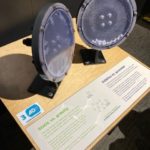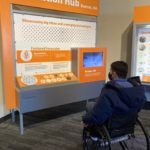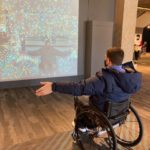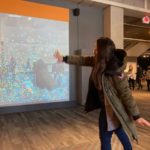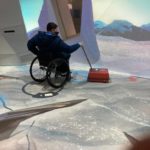Accessible Boston: Know Before You Go – Museum of Science
Written by Paul Ward
As the Director of Adaptive Sports at Franciscan Children’s, I aim to find accessible outings for families and their children. As someone living with a disability, I understand the struggle of how time-consuming and tedious it can be to research a location’s accessibility before heading out on what you hope will be a worthwhile adventure with your child. All too often when you arrive at the location, the reality is that it is not as accessible as one had originally thought, or as the website claimed it would be. This can be a frustrating and deflating start to what should have been an exciting and fun-filled day.
To ease this frustration, I plan to check out different sites around Boston and report back on what you can expect when visiting. My hope is that this will make life a little easier and take some of the guesswork out of the accessibility of different area attractions. The first location in the Accessible Boston: Know Before You Go series is the Museum of Science.
Parking and Entrance
There are a couple of parking options when you arrive at the Museum of Science. To allow for easier access into the museum, there is a visitor drop-off and pick-up location at the museum’s main entrance. Once you have gotten out of your vehicle, there is one automated entry doorway into the museum. Paid parking can be found by driving directly into the museum’s garage. Each level has accessible parking locations near an elevator. If for some reason all designated spots are occupied, the museum may allow patrons to park in the main driveway. (You will need to ask a museum staff member about this before parking in the main driveway.) Parking at the Museum of Science is not free and the cost, like most garages, is dependent on the length of your visit.
For those who take public transportation, please note that both stations closest to the museum are currently closed as of March 14, 2022.
Accessibility Services
The Museum of Science offers a variety of accessible services (see below). For a more detailed description, visit: https://www.mos.org/visit/accessibility
- Assisted listening systems and devices for various indoor theaters.
- Sighted guide tours are currently suspended, but Aira Access* is available for those who are blind or have low vision. *Aira Access enhances accessibility by providing visual interpreting services.
- American Sign Language (ASL) Interpreters and Computer Aided Realtime Transcription (CART) reporting. Please note that the museum requires a two-week notice in order to provide these services.
- Narrative description of the building layout.
- Designated quiet times for visitors with developmental disabilities, are on the Autism Spectrum, have a neurological disorders or sensory concerns.
- Free use of select mobility devices such as wheelchairs, strollers or scooters.
- Straws for drinks at the café. (You will need to request these.)
My Visit
I visited the Museum of Science on a Friday morning around 10 a.m. and stayed for approximately two hours. During this time, I went through most of the museum, but did not see any of the shows in their theaters.
I started my visit by parking in the museum’s garage. It was easy to find an accessible spot right next to the elevator. Access into the museum was also easy, as the elevator led to the main corridor.
Signage directing me to the admissions ticket window was clear, and the attendant was friendly. Children under three are free, ages three to eleven cost $24, and adults are $29. There are also membership packages available if you plan on visiting the museum multiple times throughout the year. After purchasing your secure ticket, I would recommend visiting the information desk (directly opposite the ticket window) before entering through the main turnstile. The staff at the desk can provide information about the accessibility features of the museum and assist in providing listening or mobility devices.
Exhibits
The exhibits in the museum span three floors and the elevator locations are well marked. During my visit, the exhibits included information on engineering, vaccines and human life. The museum has a wide assortment of exhibits, providing something enjoyable for any age and interest level. Most of the exhibits are hands-on and interactive, which allows for many opportunities to play and learn at the same time.
The museum is also home to a planetarium and multiple theaters, with a variety of shows available. There are additional fees associated with these programs. Be sure to check the accessibility services page to ensure the shows will be appropriate for everyone in your group.
Accessibility
Overall, I found the accessibility of the museum to be a mixed bag and in a state of transition. The accessibility features were not consistent across every exhibit, making some exhibits more difficult to enjoy. For example, the “What’s New About Nano” exhibit provided access to an audio description by using your smartphone, while the “Wicked Smart Invented in the Hub” exhibit required individuals to push a series of buttons to access an interactive audio description experience. In some cases, the volume tended to be low or the speaker was not working properly. On a positive note, all the videos I saw at exhibit locations did have closed captioning in English. Some exhibits also had descriptions written in Spanish.
Some of the more popular exhibits tended to be loud. I felt this could be overwhelming for some individuals who may be sensitive to noise. In this case, you may want to investigate the museum’s quiet hours, which is an important service. Another suggestion would be to bring noise-canceling headphones for those sensitive to noise. The light intensity varies considerably between exhibits, from softer lighting to very bright. Those with sensitivity to light should be aware of this as they select areas of the museum to visit.
For those with children and/or for individuals who have a physical disability, the heights of the activities and displays varied across exhibits. Some of the written descriptions can be seen without any trouble, but there are others that will be out of view depending on the height of an individual’s wheelchair or scooter. Similarly, the varying heights of the interactive display elements will make accessing them difficult for some visitors. You or your child might not be able to slide under some displays if using a wheelchair, but the museum does seem to have considered reach ranges for the interactive exhibits, making them accessible for most individuals.
While some of my review may be critical, I want to be clear that the accessibility services the Museum of Science provides are above and beyond many locations I have personally visited. It was clear from speaking with staff that the museum is dedicated to making everything more accessible and is currently in a transition period to make this a reality, which could explain the varying degrees of accessibility throughout the venue.
Conclusion
I think the Museum of Science has much to offer depending on your interests, physical abilities and has something for every age. Let me know where you’d like the next Accessible Boston trip to take place.




